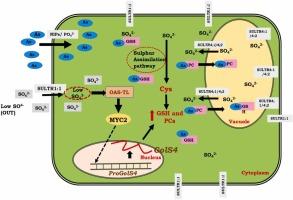半乳糖烯醇合成酶 4 需要硫同化途径来提供拟南芥在限硫条件下对砷胁迫的耐受性
IF 11.3
1区 环境科学与生态学
Q1 ENGINEERING, ENVIRONMENTAL
引用次数: 0
摘要
砷(As)毒性和营养失衡等重金属胁迫对植物的生产力和发展构成了严重威胁。植物会产生富含硫(S)的分子,如谷胱甘肽(GSH),以解毒砷,但缺硫会加重砷的影响。先前的研究发现了拟南芥在低硫(LS)和砷(III)胁迫下的生态型 Koz2-2(耐受)和 Ri-0(敏感)。对这两种不同生态型的转录组分析表明,AtGolS4在Koz2-2中被高度诱导,这表明它可能在LS+As(III)胁迫响应中发挥作用。在本研究中,Col-0、AtGolS4突变体(atgols4)和Ri-0背景下的AtGolS4过表达株系(AtGolS4OX)在LS+As(III)胁迫下表现出较小的根系生长下降,游离硫酸盐积累较低,GSH水平较高,表明AtGolS4可能在调节抗氧化剂产生以减少As(III)胁迫产生的氧化应激中发挥作用。在 AtSULTR1;2 突变体(atsultr1:1CR,通过 CRISPR/Cas9 方法开发)背景中过表达 AtGolS4 会导致敏感表型,表明硫酸盐的可用性限制了硫化合物的产生。AtGolS4 启动子分析表明缺乏硫反应元件(SURE),但发现了 MYC2 结合位点,实验表明 AtMYC2 可能调控 AtGolS4。总之,本研究强调 AtGolS4 是通过提高抗氧化能力和硫酸盐同化能力来增强对 LS 和 As(III)胁迫耐受性的关键基因。本文章由计算机程序翻译,如有差异,请以英文原文为准。

Galactinol synthase 4 requires sulfur assimilation pathway to provide tolerance towards arsenic stress under limiting sulphur condition in Arabidopsis
Heavy metalloid stress such as arsenic (As) toxicity and nutrient imbalance constitute a significant threat to plant productivity and development. Plants produce sulfur (S)-rich molecules like glutathione (GSH) to detoxify arsenic, but sulfur deficiency worsens its impact. Previous research identified Arabidopsis thaliana ecotypes Koz2-2 (tolerant) and Ri-0 (sensitive) under low-sulfur (LS) and As(III) stress. Transcriptomic analysis of the contrasting ecotypes revealed that AtGolS4 was highly induced in Koz2-2, suggesting its possible role in LS+As(III) stress response. In this study, AtGolS4 overexpressing lines (AtGolS4OX) in Col-0, AtGolS4 mutant (atgols4), and Ri-0 backgrounds showed lesser root growth reduction under LS+As(III) stress, with lower free sulfate accumulation and higher GSH levels, indicating the possible role of AtGolS4 in regulating antioxidant production to reduce oxidative stress generated due to As(III) stress. Overexpression of AtGolS4 in the AtSULTR1;2 mutant (atsultr1:1CR, developed through CRISPR/Cas9 approach) background resulted in a sensitive phenotype, suggesting sulfate availability limits sulfur compound production. AtGolS4 promoter analysis revealed absence of sulfur-responsive elements (SURE) but identified MYC2 binding sites, and experiments showed that AtMYC2 likely regulates AtGolS4. Overall, this study highlights AtGolS4 as a key gene for enhancing tolerance to LS and As(III) stress, by increasing the antioxidant capability and sulphate assimilation.
求助全文
通过发布文献求助,成功后即可免费获取论文全文。
去求助
来源期刊

Journal of Hazardous Materials
工程技术-工程:环境
CiteScore
25.40
自引率
5.90%
发文量
3059
审稿时长
58 days
期刊介绍:
The Journal of Hazardous Materials serves as a global platform for promoting cutting-edge research in the field of Environmental Science and Engineering. Our publication features a wide range of articles, including full-length research papers, review articles, and perspectives, with the aim of enhancing our understanding of the dangers and risks associated with various materials concerning public health and the environment. It is important to note that the term "environmental contaminants" refers specifically to substances that pose hazardous effects through contamination, while excluding those that do not have such impacts on the environment or human health. Moreover, we emphasize the distinction between wastes and hazardous materials in order to provide further clarity on the scope of the journal. We have a keen interest in exploring specific compounds and microbial agents that have adverse effects on the environment.
 求助内容:
求助内容: 应助结果提醒方式:
应助结果提醒方式:


